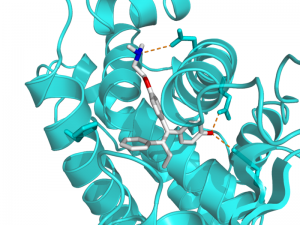Questions for ASCO – on Tamoxifen, ATLAS and aTTom
On Sunday in Chicago, oncologists and others at the plenary session of the annual ASCO meeting will be talking about an abstract that matters a lot to women with breast cancer. It’s a study on Tamoxifen that bears on how long women with estrogen-receptor positive (ER+) tumors should take adjuvant hormonal therapy after initial treatment for early-stage BC.

Why this matters so much is that ER+ tumors account for most BC cases. So if you’re a pre-menopausal woman who’s had a tumor removed by surgery, there’s a good chance your doctor will recommend adjuvant (“extra”) treatment with Tamoxifen for 5 or (probably) 10 years. The reasoning behind this recommendation is that the recently-published ATLAS study demonstrated a clear lengthening of life among women with ER+ tumors who took the longer course.
The usual dose of Tamoxifen (Nolvadex) is 20 milligrams per day. The bargain-rate cost is around $9 for a month’s supply GoodRx.com – so we’re talking just over $110/year x 5 or 10 years. That’s small change as oncology drugs go, although the numbers add up over so many patients affected…
Tamoxifen carries a small but real risk for what most doctors consider side effects, like blood clots and occasional, typically low-grade uterine cancers. The problem with Tamoxifen – which is not so much a risk as a definite consequence of taking this medication – is that it has anti-estrogen effects that many young (and older) women consider undesirable. Already our breasts have been cut. Feeling “feminine” is not trivial. Many don’t want it!
(Mental exercise: imagine hundreds of thousands of men ages 35-55 agreeably accepting a prescription for partial chemical castration to reduce the chances of a tumor recurring, after they’ve already had significant treatment to reduce those odds)
Your author has been in rooms filled with doctors where the overwhelming consensus expressed was that hormonal treatments in women with BC are terrific. Indeed, they extend life and, in some cases – such as those with low Oncotype scores – afford women the option of skipping chemo. But how are they so sure we’d rather take an anti-estrogen for 5-10 years rather than 3-6 months of chemo? Answer: I don’t think anyone knows.
One limitation of the ATLAS study (and as best I can tell the same for aTTom) is that the trial doesn’t distinguish between women who got adjuvant chemo and those who didn’t get chemo. So it’s unclear whether Tamoxifen helps prevent recurrence, or extend life, in women who’ve also received chemotherapy for the disease.
Here are 2 questions for aTTom:
1. How do we know that women with small, node-negative (low risk) tumors who receive chemotherapy, as is standard in many communities, get additional benefit from Tamoxifen after chemo?
2. Should pre-menopausal women with small, ER+ tumors be given a choice between taking chemo or Tamoxifen?
In other words, is there evidence to support the combination – chemo followed by hormonal Rx – as the standard, adjuvant care for women with early-stage, ER+ tumors? or that women prefer hormonal pills over a short course, like 4 cycles, of chemo?
I’m eager to hear about the updated aTTom (adjuvant Tamoxifen Treatment offers more?) findings, to be published and presented on Sunday. I hope my colleagues – doctors, patients, advocates and journalists will ask good questions!
All for now,
ES
I am a 61 year old male breast cancer survivor. I had a mastectomy in July of 2012, followed by 4 rounds of chemo and I am now on Tamoxifen for almost a year. Did either the ATTOM or ATLAS trials include any male patients?
Hi Joe, You raise an important issue – on the lack of data, in general, regarding optimal treatment for men with BC. I have no answers, unfortunately, except that this is a problem faced by many people with relatively rare conditions, or who by demographic or other circumstances fall outside of the “usual” range of people from whom data have been compiled and analyzed.